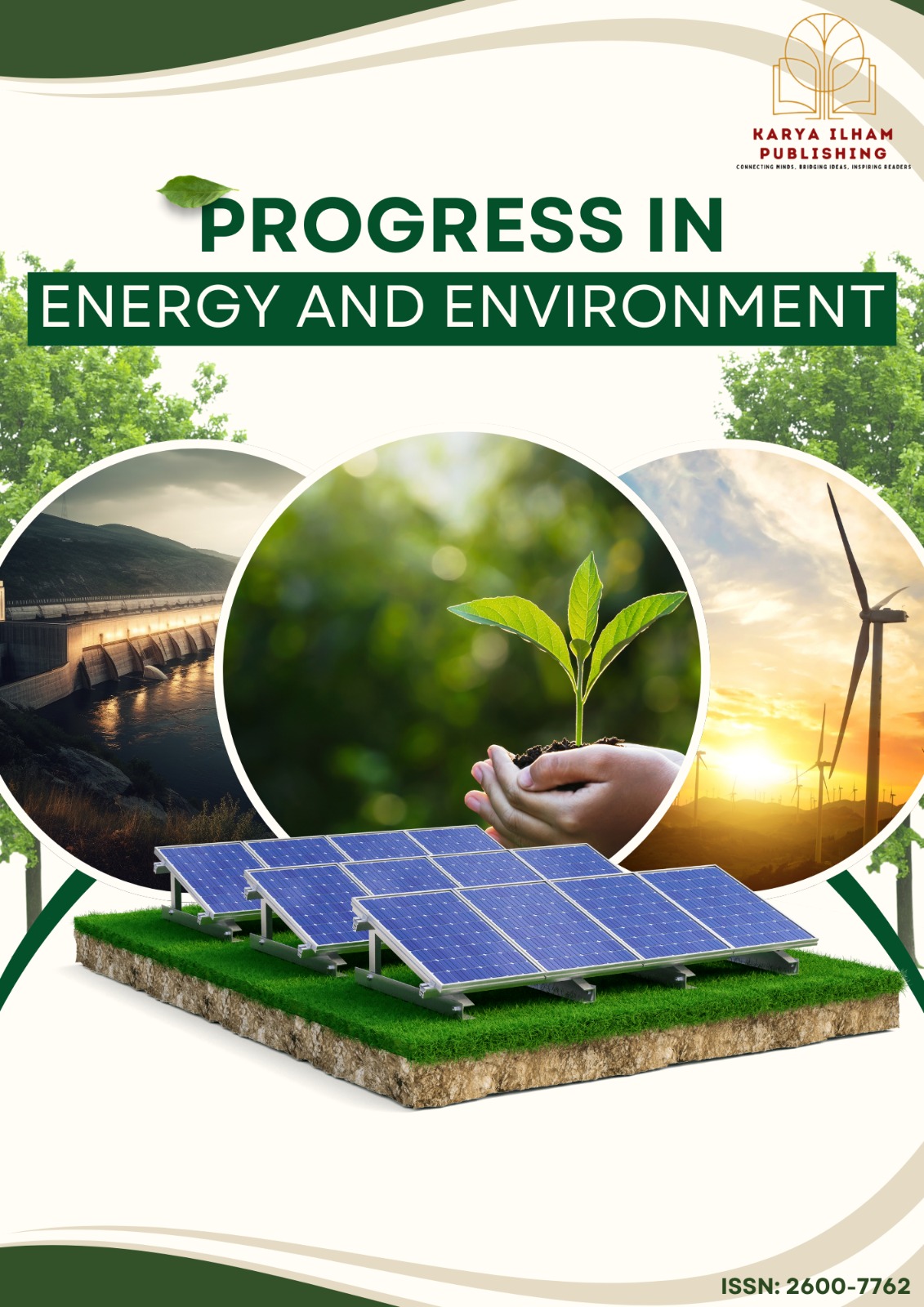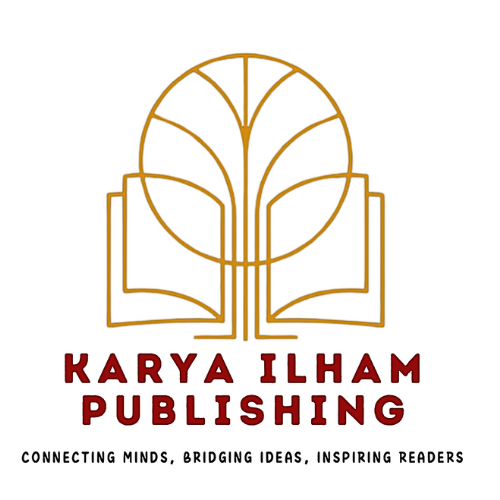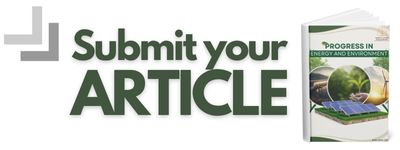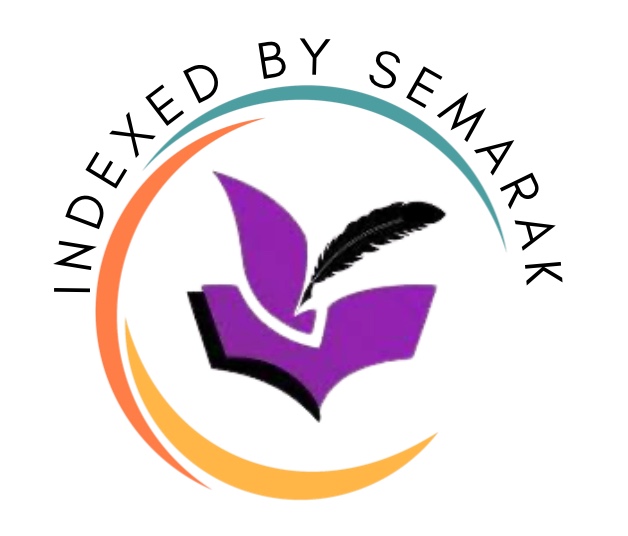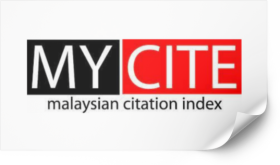Comparative Analysis of PM10 and PM2.5 Before, During, and After the COVID-19 Pandemic in Shah Alam, Malaysia
Keywords:
Air Pollution Trends, PM10, PM2.5, Shah Alam, COVID-19Abstract
Particulate matter (PM10 and PM2.5) is a major environmental and public health concern due to its ability to penetrate the human respiratory system and elevate risks of respiratory and cardiovascular diseases. This study examines the impact of COVID-19 restrictions on PM10 and PM2.5 concentrations in Shah Alam, Malaysia, from 2018 to 2023, covering three phases: pre-COVID (2018–2019), COVID (2020–2021), and post-COVID (2022–2023). Daily 24-hour mean data from the Department of Environment were analysed using the Kruskal–Wallis test with Dunn’s post hoc comparisons. Results revealed significant differences across the three phases (p < 0.001). PM10 and PM2.5 concentrations declined sharply during the COVID period by approximately 29% and 32.5%, respectively, compared to pre-COVID levels, with large effect sizes confirming substantial reductions. Post-COVID years showed modest rebounds but remained 23% (PM10) and 25.5% (PM2.5) lower than pre-pandemic baselines. These findings align with national and international evidence, underscoring the strong influence of anthropogenic activity on particulate matter levels. The results highlight the importance of integrating emission control policies with regional haze management to sustain long-term improvements in urban air quality.
References
[1] J. Guo, G. Chai, X. Song, X. Hui, Z. Li, X. Feng, and K. Yang, Long-Term Exposure to Particulate Matter on Cardiovascular and Respiratory Diseases in Low- and Middle-Income Countries: A Systematic Review and Meta-Analysis. Frontiers in Public Health 11 (2023) 1134341. https://doi.org/10.3389/fpubh.2023.1134341.
[2] World Health Organization, WHO Global Air Quality Guidelines: Particulate Matter (PM2.5 and PM10), Ozone, Nitrogen Dioxide, Sulfur Dioxide and Carbon Monoxide, 2021.
[3] S. Muhammad, X. Long, and M. Salman, COVID-19 Pandemic and Environmental Pollution: A Blessing in Disguise? The Science of the Total Environment 728 (2020) 138820. https://doi.org/10.1016/j.scitotenv.2020.138820.
[4] R. Afroz, M.N. Hassan, and N.A. Ibrahim, Review of Air Pollution and Health Impacts in Malaysia. Environmental Research 92 (2003) 71–77. https://doi.org/10.1016/s0013-9351(02)00059-2.
[5] S. Abdullah, A.A. Mansor, N.N.L.M. Napi, W.N.W. Mansor, A.N. Ahmed, M. Ismail, and Z.T.A. Ramly, Air Quality Status during 2020 Malaysia Movement Control Order (MCO) Due to 2019 Novel Coronavirus (2019-nCoV) Pandemic. The Science of the Total Environment 729 (2020) 139022. https://doi.org/10.1016/j.scitotenv.2020.139022.
[6] L. Li, Q. Li, L. Huang, Q. Wang, A. Zhu, J. Xu, Z. Liu, H. Li, L. Shi, R. Li, M. Azari, Y. Wang, X. Zhang, Z. Liu, Y. Zhu, K. Zhang, S. Xue, M.C.G. Ooi, D. Zhang, and A. Chan, Air Quality Changes during the COVID-19 Lockdown over the Yangtze River Delta Region: An Insight into the Impact of Human Activity Pattern Changes on Air Pollution Variation. The Science of the Total Environment 732 (2020) 139282. https://doi.org/10.1016/j.scitotenv.2020.139282.
[7] Y. Wang, Y. Yuan, Q. Wang, C. Liu, Q. Zhi, and J. Cao, Changes in Air Quality Related to the Control of Coronavirus in China: Implications for Traffic and Industrial Emissions. The Science of the Total Environment 731 (2020) 139133. https://doi.org/10.1016/j.scitotenv.2020.139133.
[8] S.R.A. Tahman, S.N.S. Ismail, M.F. Ramli, M.T. Latif, E.Z. Abidin, and S.M. Praveena, The Assessment of Ambient Air Pollution Trend in Klang Valley, Malaysia. World Environment 5 (2015) 1–11.
[9] S. Abdullah, M. Ismail, and S.Y. Fong, Multiple Linear Regression (MLR) Models for Long Term Pm10 Concentration Forecasting during Different Monsoon Seasons. Journal of Sustainability Science and Management 12 (2017) 60–69.
[10] M. Othman, and M.T. Latif, Air Pollution Impacts from COVID-19 Pandemic Control Strategies in Malaysia. Journal of Cleaner Production 291 (2021) 125992. https://doi.org/10.1016/j.jclepro.2021.125992.
[11] N. Banan, M.T. Latif, L. Juneng, and F. Ahamad, Characteristics of Surface Ozone Concentrations at Stations with Different Backgrounds in the Malaysian Peninsula. Aerosol and Air Quality Research 13 (2013) 1090–1106. https://doi.org/10.4209/aaqr.2012.09.0259.
[12] J.D. Gibbons, and S. Chakraborti, Nonparametric statistical inference, fifth edition, 5th edn, Chapman & Hall/CRC, Philadelphia, PA, 2010. https://doi.org/10.1201/9781439896129.
[13] D.R. Helsel, R.M. Hirsch, K.R. Ryberg, S.A. Archfield, and E.J. Gilroy, Statistical Methods in Water Resources. Techniques and Methods (2020). https://doi.org/10.3133/tm4a3.
[14] A. Dinno, Nonparametric Pairwise Multiple Comparisons in Independent Groups Using Dunn’s Test. The Stata Journal 15 (2015) 292–300. https://doi.org/10.1177/1536867X1501500117.
[15] S. Zainal, N.M. Zamre, and M.F. Khan, Emission Level of Air Pollutants during 2019 Pre-Haze, Haze, and Post-Haze Episodes in Kuala Lumpur and Putrajaya. Malaysian Journal of Chemical Engineering and Technology (MJCET) 4 (2021) 137. https://doi.org/10.24191/mjcet.v4i2.14299.
[16] S.Z. Azmi, M.T. Latif, A.S. Ismail, L. Juneng, and A.A. Jemain, Trend and Status of Air Quality at Three Different Monitoring Stations in the Klang Valley, Malaysia. Air Quality, Atmosphere, & Health 3 (2010) 53–64. https://doi.org/10.1007/s11869-009-0051-1.
[17] N.A.A.A. Rahim, N.M. Noor, I.A.M. Jafri, A.Z. Ul-Saufie, M.A. Kamaruddin, M.R.R.M.A. Zainol, A.V. Sandu, P. Vizureanu, and G. Deak, Modelling Particulate Matter (PM10) Variations during Transboundary Haze Events Using a Modified Quantile Regression Approach. Analytical Science Advances 6 (2025) e70027. https://doi.org/10.1002/ansa.70027.
[18] M. Othman, and M.T. Latif, Air Pollution Impacts from COVID-19 Pandemic Control Strategies in Malaysia. Journal of Cleaner Production 291 (2021) 125992. https://doi.org/10.1016/j.jclepro.2021.125992.
[19] S.N. Rama Naidu, and S. Chelliapan, The Impact of Movement Control Order (MCO) during COVID-19 Pandemic on Air and Water Quality in Malaysia: A Mini Review. 89 (2021) 601–606.
[20] A. Benchrif, A. Wheida, M. Tahri, R.M. Shubbar, and B. Biswas, Air Quality during Three Covid-19 Lockdown Phases: AQI, PM2.5 and NO2 Assessment in Cities with More than 1 Million Inhabitants. Sustainable Cities and Society 74 (2021) 103170. https://doi.org/10.1016/j.scs.2021.103170.
[21] P. Yeo, A. Abu Bakar, Z. Othman, M. Sahani, S. Zainudin, and Z. Suli, The Effect of Meteorology and Air Quality to the Covid-19 Cases in Malaysia: A Multivariate Deep Learning Approach. Sains Malaysiana 53 (2024) 3831–3843. https://doi.org/10.17576/jsm-2024-5311-24.
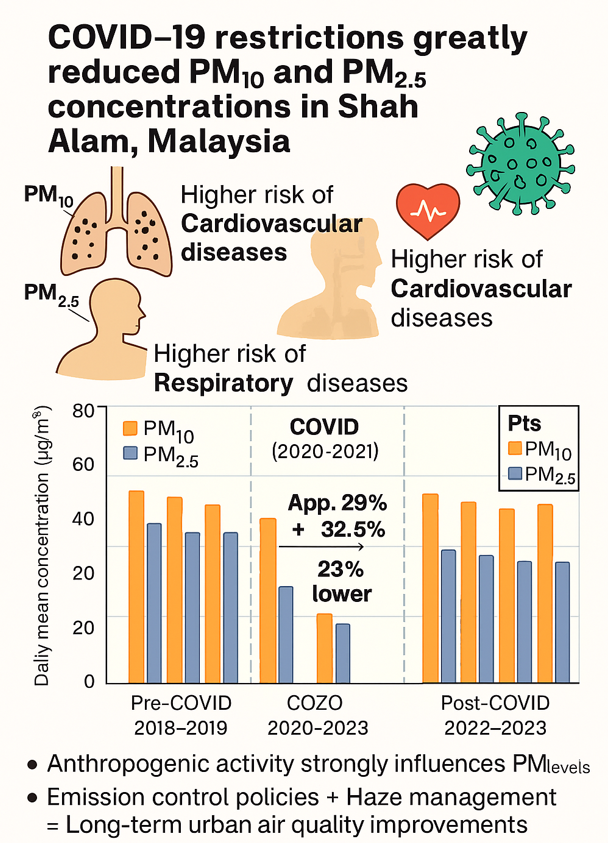
Downloads
Published
Issue
Section
License
Copyright (c) 2025 Progress in Energy and Environment

This work is licensed under a Creative Commons Attribution-NonCommercial 4.0 International License.
